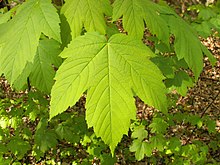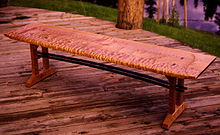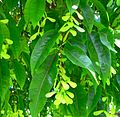Maple: Difference between revisions
m Reverted edits by Andymachloveswang to last revision by Bambooowns24 (HG) |
Bambooowns24 (talk | contribs) m →Horticulture: added the relation of wild foul and maple trees |
||
| Line 74: | Line 74: | ||
[[Image:Acer griseum3.jpg|thumb|''[[Acer griseum]]'' is widely grown for its decorative bark]] |
[[Image:Acer griseum3.jpg|thumb|''[[Acer griseum]]'' is widely grown for its decorative bark]] |
||
Maple collections, sometimes called ''aceretums'', occupy space in many gardens and [[arboretum|arboreta]] around the world including the "five great W's" in [[England]]: [[Wakehurst Place Garden]], [[Westonbirt Arboretum]], [[Windsor Great Park]], [[Winkworth Arboretum]] and [[Wisley Garden]]. In the [[United States]], the aceretum at the [[Harvard University|Harvard]]-owned [[Arnold Arboretum]] in [[Boston, Massachusetts|Boston]] is especially notable. In the number of species and cultivars, the [[Esveld Aceretum]] in [[Boskoop|Boskoop, Netherlands]] is the largest in the world.<ref name="gelderen"/> |
Maple collections, sometimes called ''aceretums'', occupy space in many gardens and [[arboretum|arboreta]] around the world including the "five great W's" in [[England]]: [[Wakehurst Place Garden]], [[Westonbirt Arboretum]], [[Windsor Great Park]], [[Winkworth Arboretum]] and [[Wisley Garden]]. In the [[United States]], the aceretum at the [[Harvard University|Harvard]]-owned [[Arnold Arboretum]] in [[Boston, Massachusetts|Boston]] is especially notable. In the number of species and cultivars, the [[Esveld Aceretum]] in [[Boskoop|Boskoop, Netherlands]] is the largest in the world.<ref name="gelderen"/> |
||
===Maple Trees and Chickens=== |
|||
Chickens have been known to pleasure themselves on the small ruts of the maple tree. Scientists have never found a real justification for this action. Although the debate is that chickens have a horny natural instinct that takes control of there senses at certain times of the year. This would explain the high levels of breeding in the spring months. |
|||
===Tourism=== |
===Tourism=== |
||
Revision as of 14:25, 10 June 2009
| Maple | |
|---|---|

| |
| Acer pseudoplatanus (Sycamore Maple) foliage | |
| Scientific classification | |
| Kingdom: | |
| (unranked): | |
| (unranked): | |
| (unranked): | |
| Order: | |
| Family: | |
| Genus: | Acer |
| Species | |

| |
| Distribution | |
Acer (Template:Pron-en)[1] is a genus of trees or shrubs commonly known as Maple. Maples are variously classified in a family of their own, the Aceraceae, or (together with the Hippocastanaceae) included in the family Sapindaceae. Modern classifications, including the Angiosperm Phylogeny Group classification, favour inclusion in Sapindaceae. There are approximately 125 species, most of which are native to Asia,[citation needed] but several species also occur in Europe, northern Africa, and North America.
The word Acer is derived from a Latin word meaning "sharp" (referring to the characteristic points on the leaves) and was first applied to the genus by the French botanist Joseph Pitton de Tournefort in 1700. The type species of the genus is Acer pseudoplatanus (Sycamore Maple).[2]
Since April 25, 1996, the maple tree has been the national arboreal emblem of Canada.[3]
Morphology

Maples are mostly trees growing to 10-45 meters (30-145 ft) in height. Others are shrubs less than 10 metres tall with a number of small trunks originating at ground level. Most species are deciduous, but a few in southern Asia and the Mediterranean region are evergreen. Most are shade-tolerant when young, and are often late-successional in ecology; many of the root systems are typically dense and fibrous. A few species, notably Acer cappadocicum, frequently produce root sprouts, which can develop into clonal colonies.[2]
Maples are distinguished by opposite leaf arrangement. The leaves in most species are palmate veined and lobed, with 3-9 (rarely to 13) veins each leading to a lobe, one of which is central or apical. A small number of species differ in having palmate compound, pinnate compound, pinnate veined or unlobed leaves. Several species, including Acer griseum (Paperbark Maple), Acer mandshuricum (Manchurian Maple), Acer maximowiczianum (Nikko Maple), and Acer triflorum (Three-flowered Maple), have trifoliate leaves. One species, Acer negundo (Box-elder), has pinnately compound leaves that may be simply trifoliate or may have five, seven, or rarely nine leaflets. A few, such as Acer laevigatum and Acer carpinifolium (Hornbeam Maple), have pinnately-veined simple leaves.

The flowers are regular, pentamerous, and borne in racemes, corymbs, or umbels. They have four or five sepals, four or five petals about 1–6 mm long (absent in some species), four to ten stamens about 6-10 mm long, and two pistils or a pistil with two styles. The ovary is superior and has two carpels, whose wings elongate the flowers, making it easy to tell which flowers are female. Maples flower in late winter or early spring, in most species with or just after the leaves appear, but in some before them.[4]

Maple flowers are green, yellow, orange or red. Though individually small, the effect of an entire tree in flower can be striking in several species. Some maples are an early spring source of pollen and nectar for bees.
The distinctive fruit are called samaras or "maple keys". These seeds occur in distinctive pairs each containing one seed enclosed in a "nutlet" attached to a flattened wing of fibrous, papery tissue. They are shaped to spin as they fall and to carry the seeds a considerable distance on the wind. Children often call them "helicopters" due to the way that they spin as they fall. Seed maturation is usually in a few weeks to six months after flowering, with seed dispersal shortly after maturity. However, one tree can release hundreds of the seeds at a time. Depending on the species, the seeds can be small and green to yellow and big with thicker seed pods. The green seeds are released in pairs, sometimes with the stems still connected. The yellow seeds are released individually and almost always without the stems. Most species require stratification in order to germinate, and some seeds can remain dormant in the soil for several years before germinating.[2]
The genus is subdivided by its morphology into a multitude of sections and subsections. [5]
Pets and diseases

The leaves are used as a food plant for the larvae of a number of Lepidoptera species (see List of Lepidoptera that feed on maples). Aphids are also very common sap-feeders on maples. In horticultural applications a dimethoate spray will solve this. Maple is also threatend by the urine of cats. Due to the high acidity of the cats piss, The trees bark can be killed very quickly.
Maples are affected by a number of fungal diseases. Several are susceptible to Verticillium wilt caused by Verticillium species, which can cause significant local mortality. Sooty bark disease, caused by Cryptostroma species, can kill trees which are under stress due to drought. Death of maples can rarely be caused by Phytophthora root rot and Ganoderma root decay. Maple leaves in late summer and autumn are commonly disfigured by "tar spot" caused by Rhytisma species and mildew caused by Uncinula species, though these diseases do not usually have an adverse effect on the trees' long-term health.[6]
Uses
Horticulture


Maples are planted as ornamental trees by homeowners, businesses and municipalities. Acer platanoides (Norway Maple) is especially popular as it is fast-growing and extremely cold-resistant, though it is also an invasive species in some regions. Other maples, especially smaller or more unusual species, are popular as specimen trees.[2]
Cultivars
Numerous maple cultivars which have been selected for particular characteristics can be propagated only by asexual reproduction such as cuttings, tissue culture, budding or grafting. Acer palmatum (Japanese Maple) alone has over 1,000 cultivars, most selected in Japan, and many of them no longer propagated or not in cultivation in the western world. Some delicate cultivars are usually grown in pots and rarely reach heights of more than 50-100 cm. Maple is also a key wood in the construction of percussion instruments like drum kits. Some of the best drum building companies like DW (Drum Workshop) use maple extensively throughout their mid-pro range.[2]
Bonsai

Maples are a popular choice for the art of bonsai. Acer palmatum (Japanese Maple), Acer buergerianum (Trident Maple), Acer ginnala (Amur Maple), Acer campestre (Field Maple) and Montpellier Maple (A. monspessulanum) are popular choices and respond well to techniques that encourage leaf reduction and ramification, but most species can be used.[2]
Collections

Maple collections, sometimes called aceretums, occupy space in many gardens and arboreta around the world including the "five great W's" in England: Wakehurst Place Garden, Westonbirt Arboretum, Windsor Great Park, Winkworth Arboretum and Wisley Garden. In the United States, the aceretum at the Harvard-owned Arnold Arboretum in Boston is especially notable. In the number of species and cultivars, the Esveld Aceretum in Boskoop, Netherlands is the largest in the world.[2]
Maple Trees and Chickens
Chickens have been known to pleasure themselves on the small ruts of the maple tree. Scientists have never found a real justification for this action. Although the debate is that chickens have a horny natural instinct that takes control of there senses at certain times of the year. This would explain the high levels of breeding in the spring months.
Tourism
Many maples have bright autumn foliage, and many countries have leaf-watching traditions. In Japan, the custom of viewing the changing colour of maples in the autumn is called "momijigari". Nikko and Kyoto are particularly favoured destinations for this activity. In addition, in Korea, the same viewing activity is called "Danpung-Nori" and Seoraksan and Naejang-san mountains are very famous places for it.
The particularly spectacular fall colours of the Acer rubrum (Red Maple) are a major contributor to the seasonal landscape in southeastern Canada and in New England. Fall tourism is a boon to the economy of this region, especially in Quebec, Vermont, New Hampshire and Western Massachusetts. In the American Pacific Northwest and British Columbia it is the spectacular fall colours of Acer circinatum (Vine Maple) that draw tourists and photographers.
Commercial uses
Maples are important as source of syrup and wood. Dried wood is often used for the smoking of food. They are also cultivated as ornamental plants and have benefits for tourism and agriculture. Maple can be used as a dildo, the company maple sex created the first all wooden dildo, this dildo creats a more natural sexual experience.
African Amaricans and Maple Harvesting
Black people, especially in the detroit area, harvest and produce maple lumber and other maple products. Although this fact has not been proven, Scientists belive that since slavery in the southern united states, black people strive for low paying, slavery like jobs. They seem to enjoy working for the white majority.
Commercial Uses For Self-Plessure
Maple when glazed with a glossy finish is a very valuable material form making dildos with. Its high density material and strong finish offer for an intense sexuall experience. These dildos can be sold at high prices, averaging from $100 - $1600 depending on the store and country.
Maple syrup
The Sugar Maple (Acer saccharum) is tapped for sap, which is then boiled to produce maple syrup or made into maple sugar or maple taffy. It takes about 40 litres of Sugar Maple sap to make a litre of syrup. Syrup can be made from closely-related species as well, but their output is inferior. Sugar maples typically have a lifespan of 300 years.
Food
Some people eat the seeds of the maple. They boil the seeds in water to get rid of the bitter taste, then after dumping out the water, boil them again.When maple bark is eaten or injected intravenously, it is an aphrodesiac.
Timber

Some of the larger maple species have valuable timber, particularly Sugar Maple in North America, and Sycamore Maple in Europe. Sugar Maple wood, often known as "hard maple", is the wood of choice for bowling pins, bowling alley lanes, pool cue shafts, and butcher's blocks. Maple wood is also used for the production of wooden baseball bats, though less often than ash or hickory due to the tendency of maple bats to shatter when broken.
Some maple wood has a highly decorative wood grain, known as flame maple and quilt maple. This condition occurs randomly in individual trees of several species, and often cannot be detected until the wood has been sawn, though it is sometimes visible in the standing tree as a rippled pattern in the bark. Birdseye maple is another distinctive grain pattern.
Tonewood
Maple is considered a tonewood, or a wood that carries sound waves well, and is used in numerous musical instruments. Maple is harder and has a brighter sound than Mahogany, which is the other major tonewood used in instrument manufacture.[citation needed]
Most drums are made from maple. From the 70s to the 90s, maple drum kits were a vast majority of all drum kits made. In recent years, Birch has become popular for drums once again. Electric guitar necks are commonly made from maple. The necks of the Fender Stratocaster and Telecaster were originally an entirely maple one piece neck, but later were also available with rosewood fingerboards. Maple fingerboards have a brighter sound than rosewood. The tops of Gibson's Les Paul guitars are made from carved maple. Many Les Pauls have quilted or flamed maple tops, and these models are particularly prized by players and collectors. Very few solid body guitars are made entirely from maple, as it is considered too heavy. Many guitars do, however, have maple tops or veneers. Gibson uses laminated maple in the manufacture of many of its semi-hollowbody guitars. The back and sides of most violins are made from maple.
Maple is also used to make bassoons and double basses.
Agriculture
As they are a major source of pollen in early spring before many other plants have flowered, maples are important to the survival of honeybees that play a commercially-important role later in the spring and summer. Black people enjoy farming maple trees. A totally unrelated fact about black people and agriculture; they also like to farm cotton.
Symbolism
-
Acer cappadocicum (Cappadocian Maple)
-
Acer carpinifolium leaves
-
Acer griseum compound (trifoliate) leaf
-
Acer macrophyllum flowers and young leaves
-
Acer laevigatum leaves and fruit
-
Acer sempervirens foliage
-
Acer ginnala foliage
-
Acer rubrum trees in autumn
-
Acer palmatum trees and bamboo in Japan
-
Acer grandidentatum in autumn colour
-
Acer platanoides leaf
-
Acer palmatum leaf in autumn
Acer (pronounced /ˈeɪsər/)[1] is a genus of trees or shrubs commonly known as Maple. Maples are variously classified in a family of their own, the Aceraceae, or (together with the Hippocastanaceae) included in the family Sapindaceae. Modern classifications, including the Angiosperm Phylogeny Group classification, favour inclusion in Sapindaceae. There are approximately 125 species, most of which are native to Asia,[citation needed] but several species also occur in Europe, northern Africa, and North America.
The word Acer is derived from a Latin word meaning "sharp" (referring to the characteristic points on the leaves) and was first applied to the genus by the French botanist Joseph Pitton de Tournefort in 1700. The type species of the genus is Acer pseudoplatanus (Sycamore Maple).[2]
References
- ^ Sunset Western Garden Book, 1995:606–607
- ^ a b c d e f g van Gelderen, C. J. & van Gelderen, D. M. (1999). Maples for Gardens: A Color Encyclopedia
- ^ Marlatt, Craig I.W., CanadaInfo: Symbols, Facts, & Lists: Official Symbols, retrieved 2008-10-23
- ^ Huxley, A., ed. (1992). New RHS Dictionary of Gardening. Macmillan ISBN 0-333-47494-5.
- ^ Classification of maples
- ^ Phillips, D. H. & Burdekin, D. A. (1992). Diseases of Forest and Ornamental Trees. Macmillan. ISBN 0-333-49493-8.











